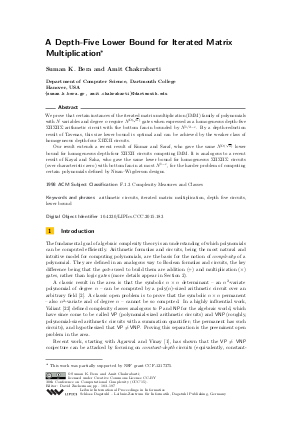A Depth-Five Lower Bound for Iterated Matrix Multiplication
Authors Suman K. Bera, Amit Chakrabarti
-
Part of:
Volume:
30th Conference on Computational Complexity (CCC 2015)
Part of: Series: Leibniz International Proceedings in Informatics (LIPIcs)
Part of: Conference: Computational Complexity Conference (CCC) - License:
 Creative Commons Attribution 3.0 Unported license
Creative Commons Attribution 3.0 Unported license
- Publication Date: 2015-06-06
File

PDF
LIPIcs.CCC.2015.183.pdf
- Filesize: 476 kB
- 15 pages
Document Identifiers
Subject Classification
Keywords
- arithmetic circuits
- iterated matrix multiplication
- depth five circuits
- lower bound
Metrics
- Access Statistics
-
Total Accesses (updated on a weekly basis)
0PDF Downloads0Metadata Views
Abstract
We prove that certain instances of the iterated matrix multiplication (IMM) family of polynomials with N variables and degree n require N^(Omega(sqrt(n))) gates when expressed as a homogeneous depth-five Sigma Pi Sigma Pi Sigma arithmetic circuit with the bottom fan-in bounded by N^(1/2-epsilon). By a depth-reduction result of Tavenas, this size lower bound is optimal and can be achieved by the weaker class of homogeneous depth-four Sigma Pi Sigma Pi circuits. Our result extends a recent result of Kumar and Saraf, who gave the same N^(Omega(sqrt(n))) lower bound for homogeneous depth-four Sigma Pi Sigma Pi circuits computing IMM. It is analogous to a recent result of Kayal and Saha, who gave the same lower bound for homogeneous Sigma Pi Sigma Pi Sigma circuits (over characteristic zero) with bottom fan-in at most N^(1-epsilon), for the harder problem of computing certain polynomials defined by Nisan-Wigderson designs.
Cite As Get BibTex
Suman K. Bera and Amit Chakrabarti. A Depth-Five Lower Bound for Iterated Matrix Multiplication. In 30th Conference on Computational Complexity (CCC 2015). Leibniz International Proceedings in Informatics (LIPIcs), Volume 33, pp. 183-197, Schloss Dagstuhl – Leibniz-Zentrum für Informatik (2015)
https://doi.org/10.4230/LIPIcs.CCC.2015.183
BibTex
@InProceedings{bera_et_al:LIPIcs.CCC.2015.183,
author = {Bera, Suman K. and Chakrabarti, Amit},
title = {{A Depth-Five Lower Bound for Iterated Matrix Multiplication}},
booktitle = {30th Conference on Computational Complexity (CCC 2015)},
pages = {183--197},
series = {Leibniz International Proceedings in Informatics (LIPIcs)},
ISBN = {978-3-939897-81-1},
ISSN = {1868-8969},
year = {2015},
volume = {33},
editor = {Zuckerman, David},
publisher = {Schloss Dagstuhl -- Leibniz-Zentrum f{\"u}r Informatik},
address = {Dagstuhl, Germany},
URL = {https://drops.dagstuhl.de/entities/document/10.4230/LIPIcs.CCC.2015.183},
URN = {urn:nbn:de:0030-drops-50622},
doi = {10.4230/LIPIcs.CCC.2015.183},
annote = {Keywords: arithmetic circuits, iterated matrix multiplication, depth five circuits, lower bound}
}
Author Details
References
-
Manindra Agrawal and V Vinay. Arithmetic circuits: A chasm at depth four. In Proc. 49th Annual IEEE Symposium on Foundations of Computer Science, pages 67-75, 2008.

-
Stuart J. Berkowitz. On computing the determinant in small parallel time using a small number of processors. Inform. Process. Lett., 18(3):147-150, 1984.

-
Devdatt P Dubhashi and Alessandro Panconesi. Concentration of measure for the analysis of randomized algorithms. Cambridge University Press, 2009.

-
Hervé Fournier, Nutan Limaye, Guillaume Malod, and Srikanth Srinivasan. Lower bounds for depth 4 formulas computing iterated matrix multiplication. In Proc. 46th Annual ACM Symposium on the Theory of Computing, pages 128-135, 2014.

-
Dima Grigoriev and Marek Karpinski. An exponential lower bound for depth 3 arithmetic circuits. In Proc. 30th Annual ACM Symposium on the Theory of Computing, pages 577-582, 1998.

-
Dima Grigoriev and Alexander Razborov. Exponential lower bounds for depth 3 arithmetic circuits in algebras of functions over finite fields. Applicable Algebra in Engineering, Communication and Computing, 10(6):465-487, 2000.

-
Ankit Gupta, Pritish Kamath, Neeraj Kayal, and Ramprasad Saptharishi. Approaching the chasm at depth four. In Proc. 28th Annual IEEE Conference on Computational Complexity, pages 65-73, 2013.

-
Ankit Gupta, Pritish Kamath, Neeraj Kayal, and Ramprasad Saptharishi. Arithmetic circuits: A chasm at depth three. In Proc. 54th Annual IEEE Symposium on Foundations of Computer Science, pages 578-587, 2013.

-
Kumar Joag-Dev and Frank Proschan. Negative association of random variables, with applications. Ann. Stat., 11(1):286-295, 1983.

-
Neeraj Kayal, Nutan Limaye, Chandan Saha, and Srikanth Srinivasan. An exponential lower bound for homogeneous depth four arithmetic formulas. In Proc. 55th Annual IEEE Symposium on Foundations of Computer Science, 2014.

-
Neeraj Kayal, Nutan Limaye, Chandan Saha, and Srikanth Srinivasan. Super-polynomial lower bounds for depth-4 homogeneous arithmetic formulas. In Proc. 46th Annual ACM Symposium on the Theory of Computing, pages 119-127, 2014.

-
Neeraj Kayal and Chandan Saha. Lower bounds for depth three arithmetic circuits with small bottom fanin. Technical Report TR14-089, ECCC, 2014.

-
Neeraj Kayal, Chandan Saha, and Ramprasad Saptharishi. A super-polynomial lower bound for regular arithmetic formulas. In Proc. 46th Annual ACM Symposium on the Theory of Computing, pages 146-153, 2014.

-
Neeraj Kayal and Ramprasad Saptharishi. A selection of lower bounds for arithmetic circuits, pages 77-115. Springer Verlag, April 2014.

-
Pascal Koiran. Arithmetic circuits: The chasm at depth four gets wider. Theor. Comput. Sci., 448:56-65, 2012.

-
Mrinal Kumar and Shubhangi Saraf. On the power of homogeneous depth 4 arithmetic circuits. In Proc. 55th Annual IEEE Symposium on Foundations of Computer Science, 2014.

-
Noam Nisan and Avi Wigderson. Hardness vs. randomness. J. Comput. Syst. Sci., 49(2):149-167, 1994.

-
Noam Nisan and Avi Wigderson. Lower bounds on arithmetic circuits via partial derivatives. In Proc. 36th Annual IEEE Symposium on Foundations of Computer Science, pages 16-–25, 1995.

-
Ramprasad Saptharishi. Recent progress on arithmetic circuit lower bounds. Bulletin of the EATCS, 114, 2014.

-
Amir Shpilka and Amir Yehudayoff. Arithmetic circuits: A survey of recent results and open questions. Found. Trends Theor. Comput. Sci., 5(3-4):207-388, 2010.

-
Sébastien Tavenas. Improved bounds for reduction to depth 4 and depth 3. In Proc. 38th International Symposium on Mathematical Foundations of Computer Science, pages 813-824, 2013.

-
L. G. Valiant. Completeness classes in algebra. In Proc. 11th Annual ACM Symposium on the Theory of Computing, pages 249-261, 1979.

-
Leslie G. Valiant, Sven Skyum, S. Berkowitz, and Charles Rackoff. Fast parallel computation of polynomials using few processors. SIAM J. Comput., 12(4):641-644, 1983.

